You know the old saying, “the right tools for the job…”
Those of us who lived in North America through the 70s and beyond probably remember the non-profit Public Broadcasting Corporation (PBS) regularly playing 16mm films of a man named Dick Proenneke, who retired at age 50 in 1967 and decided to build his own cabin on the shore of Twin Lakes in the Alaskan wilderness. The first summer he scouted for the best cabin site, and cut and peeled the logs he would need for his cabin, then went back and built it well enough to survive the harsh Alaskan weather for months at a time.
Those old films have mesmerized and inspired generations. The series was an early prototype for an entire “living off grid” genre now on YouTube that exploded in popularity during the pandemic. We love to romanticize the lone human against a brutal, unforgiving natural habitat. Proenneke had the simplest of hand-powered tools, jumped into a canoe and headed out into the wilderness, built a cabin, hunted, gathered and fished for sustenance, and filmed the whole thing himself with a 16mm film camera and tripod. Sounds familiar to any independent YouTube content creator.
Humans love watching other humans use tools because tool making and tool use are, with only a few exceptions in nature, distinctly homo sapien. That combined with our ability to collaborate in complex groups, communicate ideas forward to our peers and offspring allowed our species to eventually dominate the earth. Hmm, that seems like a reasonable anthropological definition of technology. Technology is not just the thing, but the idea of a potential thing, how to make a thing and use a thing in relation to other things. Here’s the rabbit hole of memetics if you’d like to dive into that epistemological paradigm.
There’s a temptation to romanticize Proenneke’s remarkable feat and think of that good ol’ spirit of hard work and rugged individualism. Aha! I don’t have to deal with all these pesky humans, I just need a canoe, an axe, a knife, a fishing pole and a rifle! That misses the point. Dick may have been using the simplest of tools, but he actually had very advanced technology on his side.
It was in his noggin. He learned it from other humans.
Dick’s dad was a veteran of WWI and worked as a carpenter. He taught his son carpentry, hunting and fishing. Dick served in the Navy during WW2 as a carpenter and also worked professionally as a carpenter, farmer and later a diesel engineer of high aptitude after the war. Dick also was an avid reader and tinkerer. He was a conservationist. He was a loner, but he filmed his expeditions because he wanted to share his technology and humble achievements with the world. He became a folk hero as a result and his films have raised untold funding for non-profit organizations for over half a century and still going.
I value utility. I like stuff that works. I like stuff that continues to reliably work for a long time. I dislike the ever-growing trend toward disposable consumer goods. Because of automation, globalization, exploitation of cheap labor, and the cost benefit of fix vs. replace, appliances, tools and systems these days are very short-sighted in their quality and designs. This may change as the global trade situation tightens and the post-Bretton-Woods age of American neo-liberalism recedes into 20th century history.
I see efficient durable technology as elegant, even beautiful. As a person who works in software engineering, I have a pretty high tolerance for complexity, but prefer a reduced set of simple and reliable tools that I’ve mastered to get from point A to point B.
It’s very easy to over-engineer a system. John Gall pondered in his somewhat amusing 1977 book Systemantics that systems are inherently problem-prone due to over-engineering. Some of the ideas in Systemantics probably directly or indirectly influenced the ideas of “Uncle Bob” Martin on Object Oriented Programming and Microservices architectures. I like Elon Musk’s “five step algorithm” that focuses on recursive minimization and optimization — when you add something to a system, you should try to take one or two things away.

Most software that isn’t entertainment or priming your dopamine receptors to spy on you is a tool to do stuff. I think we call that classification productivity, right? A productive life is a good life, or at least some seem to think so. Software tools are like regular tools but very different from a hammer or shovel in that software has the potential to be copied and distributed infinitely. Software is not unlike ideas in that regard. Software may be like memetic material in the digital domain. Wikipedia describes memetic computing as a “novel computational paradigm,” so I’m not the first to make this connection. Perhaps memetics is conceptually obvious but its useful for the purposes of this discussion; If you could clone hammers, picks and shovels for free, you’d never have to go buy them. Everyone would have them. More importantly, communities of people would have a shared interest to communicate and evolve innovations of those tools.
You have good tool! Me have? Yes, you have. Now we both have good tool! Make Grug happy.
That’s the point of the free software movement. Software engineers are readily familiar with this concept. It’s fundamentally human to share ideas and technology.
My longtime friend and professional colleague is engaged in contributing to the free software community. He spends all day working in software for a corporation, and then builds a free elite distribution of Linux called Aegix in his own time. He does it because he likes and wants reliable tools that work for advanced application. The free software movement doesn’t have an agenda. It’s communal and usually focused on utility value, function and reliability over form and profit. I’ve been interested in the free software movement for a quarter of a century now. I don’t think you’d be reading this right now and the Internet probably wouldn’t exist if it weren’t for the free software movement. A substantial number of critically historic innovations were purely because somebody had an idea and wanted to do it. Tinkerers ahoy!
Now, since this blog is primarily concerned with audio engineering and the making of music sounds, naturally, I have to share a few related ideas that I’ve gathered along my journey related to the software tools we use to make music.
When you work on a project, you never know how long that project is going to take. Sometimes projects take years. Sometimes you need to return to projects that are from a long time ago. Since most of us music production enthusiasts are doing 99% of our work in the digital domain these days, we unfortunately have to use software systems that are designed for obsolescence. This is very annoying. I’d say the biggest problem with digital audio production is that the systems are too ephemeral to be reliable, and at this point in history, it’s not the hardware! Software operating systems change because their creators want you to buy new versions. Digital Audio Workstations change because their creators want you to buy new versions. The processing tools we call plugins that work in our DAWs change and we have to deal with the problem of forward and backward compatibility.
There are thousands of audio engineers who have “projects” dutifully backed up on a hard drive or cloud somewhere, but can’t open them for revisions because the project isn’t compatible with the latest host, OS, some new driver, or regression in an non-standardized API and most certainly, the 250 audio plugins they may have used don’t work and the binaries may not even be available because the makers wanted to destroy the old versions to sell you new versions. There are archival service companies (libraries and such) that maintain legacy systems and operating systems to help retrieve legacy materials, or you can spend days sourcing a computer and all the original software to rebuild a legacy system — assuming that the software is still available. There are many reasons why software becomes “obsolete” — fundamental incompatibilities with hardware design paradigms are the main cause, but in many cases proprietary software companies love planned obsolescence. Greed. Profit.
The for-profit software engineering industry is essentially the relationship between the fictional characters Biff & Marty McFly writ large in a corporate hierarchy. Most software engineers who haven’t internalized the psychology of subordination within a bureaucratic hierarchy are well aware that they are perfectly capable of self-organizing and making software without the power elite and their echelons of executive and middle management peons. Market success is a different matter. Competition moves the ball. Competition is good. Salaries and non-wage benefits are always an attractive and equitable arrangement, but cynicism and alienation often emerge out of that compromise. Outside of well-designed R&D organizations (Bell Labs for example) most of the great innovative teams throughout modern history are a small team of engineers, maybe a few “creatives” and an VC. As soon as AI can replace Grug at scale, the power-elite will do it. It’s not a matter of if, only when. It’s already happening. In the meantime, it will be your typical speculative gold-rush, and the folks selling the picks and shovels will get rich.
A good example of this Pro Tools
Yes, it’s another “two guys in a garage” story.
Peter Gotcher and Evan Brooks, two UC Berkeley grads with majors in computer science and electrical engineering, created Pro Tools. Like most of the innovations in computer science, it’s a story of a couple of computer geeks who also had other interests. In this case it was electronic music.
The two buddies decided to research the memory mapping of the recently introduced E-mu Drumulator drum machine in 1983 in order to produce EPROM sound replacement chips because they both had an interest in music and electronic and software engineering. Despite having only built-in samples at the time, the Drumulator was highly popular.
A year later, they rebranded the chips as Digidrums and began selling the upgrades. It was a hit product. Following the 1984 debut of Apple’s first Macintosh computer, the two set out to create a more versatile and effective solution that would make use of a graphical user interface. They worked with E-Mu to create Sound Designer, a Mac-based visual sample editing program for the Emulator II keyboard that was marketed under the Digidesign name and this was the progenitor of ProTools DAW.
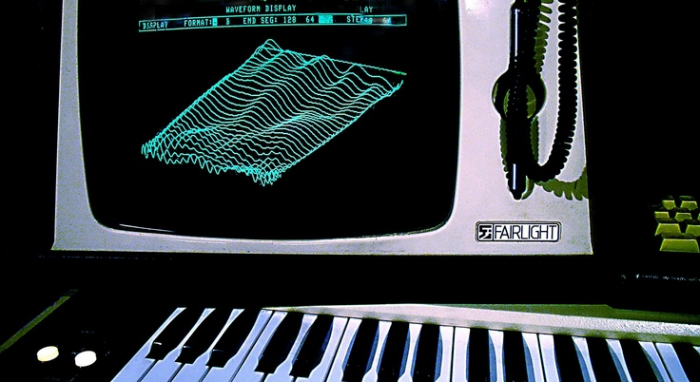
When the Apple Macintosh II was introduced in 1987, with card slots, a hard drive, and more powerful RAM, Brooks and Gotcher realized that Sound Designer could become a fully functional digital audio workstation. The principles of the GUI for audio sequencing via MIDI were well established early on with systems by Fairlight and Synclavier, so it was only natural that the idea of the DAW would evolve from that once the hardware problems were solved. They decided to create the hardware as well as the software. Motorola recruited the two to contribute to the development of its 56K family of digital signal processors. Brooks created the software to interface the processor with Sound Designer after designing the circuit board for the processor. By December 1988, a beta version of the DSP was available.

KVR Audio has a retrospective article (unfortunately the author writing in first person is somehow uncredited) on the story behind early GUI waveform DSP tools, OpCode and Digidesign.
Pro Tools II was released in 1994. The editor and the mixer were merged into a single Pro Tools application that utilized the Digidesign Audio Engine (DAE) created by Peter Richert. DAE was also provided as a separate application to favor hardware support from third-party developers, enabling the use of Pro Tools hardware and plug-ins on other DAWs. Selling more than 8,000 systems worldwide, Pro Tools II became the best-selling digital audio workstation.
I performed on my first all-digital disc-based recording session with my band, The Psychotronic Blues Unit in the back room of an Auburn Alabama music store in 1994. Everyone stood around the computer and despite the limitation of only stereo input, incredibly sterile flat sound and a complete lack of any usable in-the-box effects DSP, we all knew this would be the future.
In the same year, Digidesign announced that it merged into the American multimedia company Avid.
The migration from traditional, tape-based analog studio technology to the Pro Tools platform was gradual in the industry. Ricky Martin’s “Livin’ la Vida Loca” in 1999 was the first number-one single to be recorded, edited, and mixed entirely within a DAW. The sound quality was also widely debated on the internet because the session was tracked in 16bit/44.1 resolution. The debate over digital sample rate and bit depth will probably go on forever. Since that rabbit hole bores me to tears, I’ll just link to Justin at Sonic Scoop who diplomatically summarizes the same position I’ve had for years far better than I can.
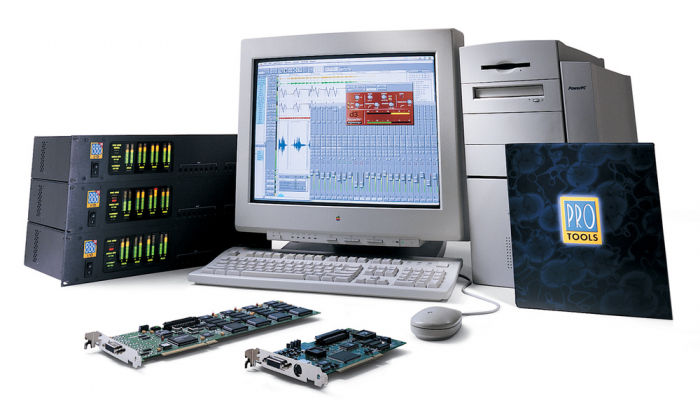
By the late 90s, ProTools faced fierce competition from the rapidly emerging power of consumer-grade computer equipment and products such as Steinberg’s Cubase and Cakewalk’s SONAR. In 1999, Digidesign introduced the Digi001 bundle, consisting of Pro Tools LE, a version that maximized compatibility with consumer computer systems and a rack-mount audio interface with eight inputs and outputs with 24-bit, 44.1/48 kHz capability and MIDI connections. Eight inputs of 24 bit audio is still the magic “sweet spot” for indie music production because it allows enough channels to track a multi-mic drum kit configuration. The Digi001 would spark a highly competitive arms race in the prosumer market over the next decade, and turn the pro audio industry upside down.
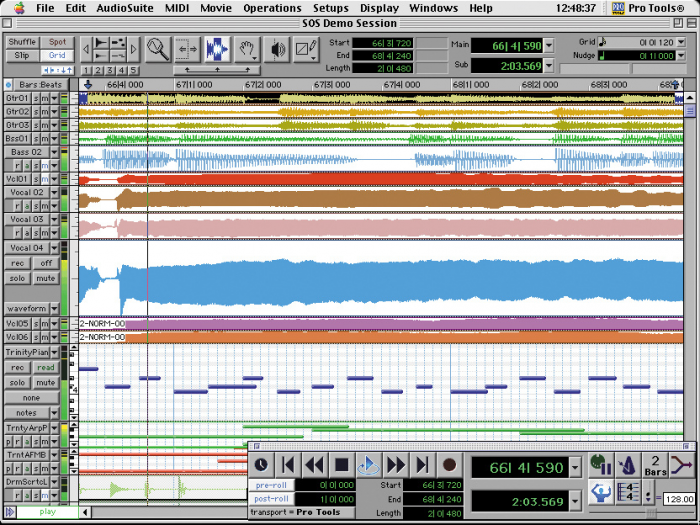
ProTools licenses and hardware were always expensive, especially compared to their competitors, but to be fair, ProTools pricing tiers were aimed at the professional marketplace with ProTools LE offered as a lower cost alternative to stave off the inevitable rise of alternatives that cannibalized their business model. By the 2010s, Apple Logic, Presonus Studio One and Reaper entered the marketplace just as Avid corporation attempted to shift ProTools to an “annual subscription model” which is like telling your customers, you can no longer own new versions of the software, but you can rent it annually. The fallout was a disaster as many professionals left the platform. Only this year did AVID realize their mistake, and offer a perpetual license option for $600.00. 33% more expensive than Studio One Professional and 600% more than Reaper‘s independent creator license.
As a result of “first mover advantage,” the professional audio industry standardized on Avid Pro Tools a long time ago. There’s essentially no way to collaborate without going through ProTools’ proprietary project format unless you have control of a project from start to finish (excluding mastering, which is just a WAV file). That doesn’t mean engineers are restricted to work in Pro Tools, that just means they have to have a copy of ProTools on hand on some system to convert, or pay someone to do it. I don’t use Avid products and will pay someone to transfer if needed. To be fair, ProTools has made reasonable efforts to maintain backward compatibility with old projects, and if you’re using ProTools, it’s certainly a rational choice, and “just the cost of doing business,” but you will be constantly paying a premium for updates and upgrades to stay current with collaborators. It’s like the old saying about corporate software, “nobody gets fired for choosing IBM(60-80s)/Microsoft(>1995).”
Let me be clear that I have absolutely no problem with the paid software model. Great products are always worth paying for. The sad thing is that just about every great software company that had cool licensing models eventually is sold to a large corporate conglomerate that f*cks it up. It’s almost an inevitability that the original innovative developers who built the core value reach a point where they are pushed out by the suits or simply want to retire and “cash out.”
Here are some of the practical strategies I use to avoid this problem:
- Your audio workstation should be treated like a mission critical system or appliance that you maintain in isolation, not like an internet cafe. I run an offline “air gapped” system for all audio production in my studio mixing room. Stable operating systems remain stable as long as the hardware doesn’t fail and I/O is strictly managed via removable device. Computers don’t magically “catch bugs” unless you connect them to a network or foolishly install a bad program from removable media. Connecting a computer to a network introduces entropy. Entropy is the enemy of stability. Before installing new software (via removable storage), back the system up every time. This is the old way we managed software before the internet. Computers of the early era shipped with a copy of the operating software on physical media. Beyond any latent bugs in the OS, you could run it indefinitely without security patches. It was an non-networked appliance. It was reliable for years, even decades as long as the hardware lasted.
- Find a set of reliable audio processing tools that don’t have restrictive proprietary licenses and maximize flexibility of portability and generational compatibility. For this reason, and because I choose to work offline, I’ve never used a plugin that requires iLok. I also necessarily avoid network based authorization (most good software manufacturers allow you a loophole for an offline authorization key). It’s absurd to require an internet connection to run productivity software. Many times I have desired a software plugin and scrolled down to the specifications to find a restrictive license model that I could not abide, and thus sought alternatives that ultimately improved my knowledge, as many DSP products are simply combinations of garden variety processes with an attractive UI and marketing hype.
- Keep redundant backups of:
- All plugin binaries with any license keys as text files (ideally encrypted). VST-64 is going to be backward compatible for a VERY long time. Chances are your favorite plugins are going to last if you keep copies.
- Your stable OS/DAW combination. Ideally, run an OS that you can backup as a system image. Upgrading is a major transition, so have a fallback. In ten years, you could run your exact system as a virtual machine. Moore’s law has slowed, but it’s still chugging along.
- Render everything. Bounce all virtual instruments. Bounce all processed channel audio. When you get done with a mix, and want to back it up, export stems of everything. You’ll thank yourself later. At minimum, if you’re like me and mix “top down” in buss channels or subgroups, at least export the groups as stems. I usually print FLAC 24/48 stems to backup as I iterate through a mix. That way, if all else fails, I have stems. This habit has paid dividends over the past twenty years more times than I can count.
Advanced Strategies For Durability
The ultimate freedom in an digital audio workstation at this point in history is a Linux operating system running Reaper. Cockos is a great small software company run by Justin Frankel that makes a fantastic product with an incredibly fair licensing model. Their DAW is known for being rock solidly stable, regularly updated with free version upgrades, highly customizable and they do a good job maximizing compatibility with everything possible. Their entire business model is based on the principle of freedom and their products are worthy of serious consideration. Their user base is extremely loyal and active on their community forums to help troubleshoot problems.
Ardour has been a promising candidate for years, but the community simply hasn’t proven strong enough to develop a viable competitor to Reaper that is stable, because most serious producers are more than willing to pay for quality and dependability, especially when there are otherwise many completely free and stable commercial options available for hobbyists. Ardour is trying to build a free product with a small team of volunteers that seems to struggle to gain market adoption because, well, GarageBand is great software. An independent musician can make a great album in GarageBand because Apple knows how to make software that maximizes usability and quality for non-professionals.
Great Tools with Freedom
The power of the modern pro DAW is the ability to leverage all the power your CPU/GPU has to offer to manipulate hundreds of audio sources or power scores of virtual instruments. There are no limits or rules, only your creativity and ability to achieve a satisfying mix. However, the fundamental building blocks of compression, EQ, and limiting are probably 90% of your workflow. Many aspiring engineers find themselves constantly purchasing and trying various highly redundant plugins whereas veterans often utilize the channel strip schema of analog mixing consoles, where a reliable multi-purpose tool can be used on every source for consistent, familiar control and rapid workflow.
Solid State Logic consoles are legendary and many of the greatest records of the past 40 years were mixed using them. SSL has licensed their branding and IP to multiple software companies who’ve modeled the behavior and interface of their classic consoles.
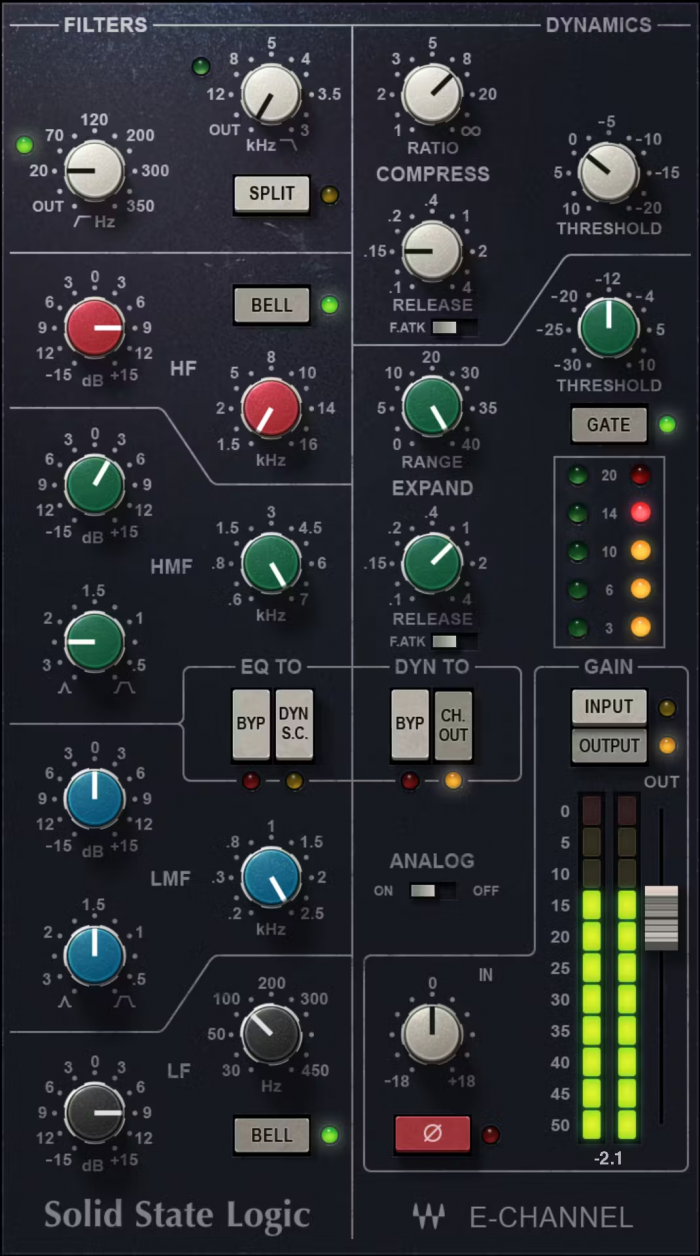
Steve Walker developed a free channel strip inspired by many of the same design principles with lower CPU overhead, clinical transparency and absolutely no license restrictions. Don’t be fooled by the more rudimentary UI compared to the SSL, it’s a professional tool with tremendous potential to craft perfect mixes. The downside is it’s only available in Windows binaries.
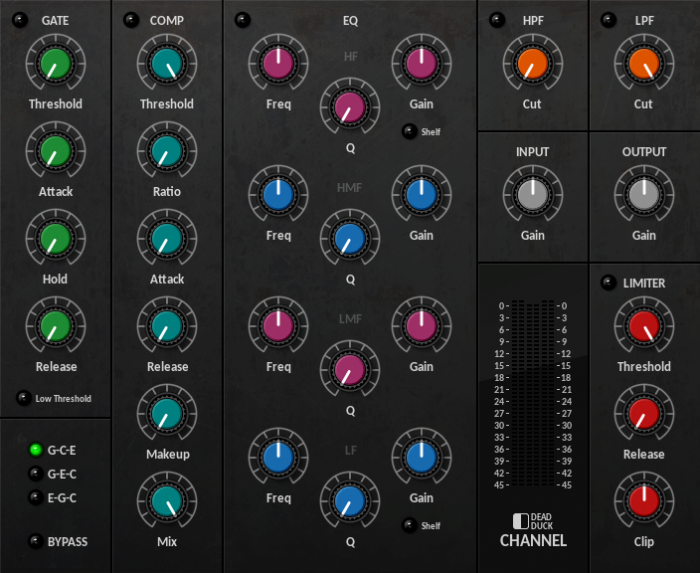
The following offerings are pro quality elite processors, built by incredibly talented software engineers and deserve the highest praise for their free contributions to the audio production community.
- Tokyo Dawn Labs – TDR Tokelnekov is one of the finest and most transparent buss compressors ever designed
- Variety Of Sound – “Bootsie” is a legendary software engineer in the DSP space who dedicated a lot of free time and R&D into the development of “stateful saturation” models that are both CPU efficient and sound gorgeous. His plugins are mostly designed for applying analog flavor in ways that are only possible in DSP. His plugins were so essential to my workflow that I stayed in a 32-bit version of Cubase for years.
- Dead Duck Software – Steve Walker has contributed the ultimate portable utility set loosely based on SSL channel processing. Stable, transparent, efficient and easy to use, his channel strip will be immediately familiar with SSL users and is something you can confidently build entire mixes around and easily port from system to system.
- VladG (Later joined the Tokyo Dawn Labs team) has legacy processors that are still incredible tools
- ReaPlugs – Quite possible the greatest utility suite ever assembled is now practically vintage software. The previously mentioned DAW Reaper was so adamant about portability and freedom that they’ve offered their core utility plugins as free VSTs since day one. If you judge your software based on snazzy UI, you may overlook the tremendous power that these tools offer.

